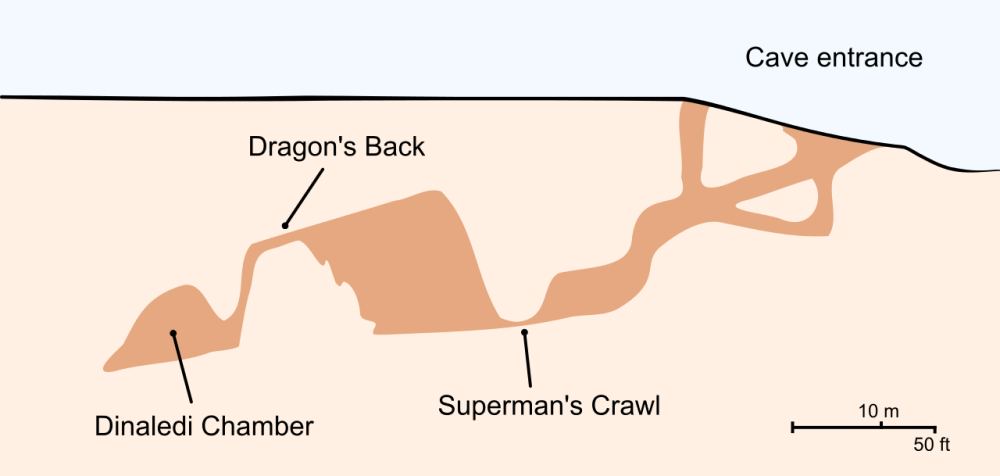The Rising Star cave system is a tangle of tunnels located within South Africa’s Cradle of Humankind, which is one of the richest known fossil hominin sites in the world. In 2013, researchers exploring the narrow passages stumbled upon what they believed to be a burial chamber in an area known as Dragon’s Back. Burial chambers are nothing new, but one established by a group of mini hominins that lived 250,000 years before it was believed early humans began making graves and art? That sure was something.
The new species Homo naledi was announced in 2015 by a team led by Professor Lee Berger of Witwatersrand University following the discovery of an astonishing 15 individuals in the Rising Star Cave. The species overlapped with Homo sapiens and had a perplexing mix of primitive and modern characteristics, with similar hands and feet to us but brains comparable to that of a chimpanzee.
However, whether H. naledi marked the beginning of the concept of an afterlife among our bipedal ancestors has become the topic of heated debate. The idea that they were practicing funerary rituals at a time when even our own ancestors weren’t has been tough for some to grapple with, while others suggest the “carvings” found here may be the result of geological processes creating fissures in the rock.

Crawling into the Rising Star Cave required a group of “underground astronauts” capable of squeezing through its narrow tunnels.
As the star of a recent Netflix documentary, the H. naledi burial chamber debate has reenergized – but it’s not all the Rising Star Cave is famous for. The significant archaeological site is located near the town of Krugersdorp in the Gauteng province of South Africa, a place that’s no stranger to deep cave systems, being the home of the world’s deepest mine.
However, unlike the Mponeng gold mine that relies on elevator-like shafts to ferry miners 4 kilometers (2.5 miles) into the ground, The Rising Star Cave is a lot harder to access. The stories of clambering head-first into the darkness through 17.5-centimeter (6.9-inch) gaps make for tense reading, but a team of “underground astronauts” successfully embarked on the perilous 200-meter (656-foot) clamber to find the remains.
In the end, 1,500 fossils from at least 15 individuals were retrieved from a tiny space nicknamed “the puzzle box” for the way the bones were stacked on one another like Jenga. By the end of their first week, Berger and colleagues “had more individuals than ever before in the entire history of human origins,” Berger said.

The geological and taphonomic context and distribution of fossils, sediments and flowstones within the Dinaledi Chamber where the H. naledi individuals were found.
In light of the sheer volume of discoveries made in The Rising Star cave, some feel the public speculation regarding burial practices among these hominins has detracted from the real value of the site.
“Rising Star is such a great site and the naledi material is so wonderful that there was really no need to over-egg the pudding,” said Prof Chris Stringer of the Natural History Museum, London, to The Guardian. “It’s going to cause problems of credibility in future, which may even affect funding for more work.”
Researchers delving into the network of narrow passages also found evidence of fires deep within the cave system, marked by burned animal bone and mounds of charcoal. Whether these were created by H. naledi or a later species isn’t known for certain, but it would be an explanation for how they or later human ancestors were navigating such a dark and difficult-to-access habitat.
While the debate surrounding Homo naledi and The Rising Star cave surge on, so too do explorations into the winding cave system. Fingers crossed we’ll have a fresh glut of archaeological evidence to fight over soon.
Source Link: A "Puzzle Box" Of Remains Were Found Stuffed Deep Inside The Rising Star Cave